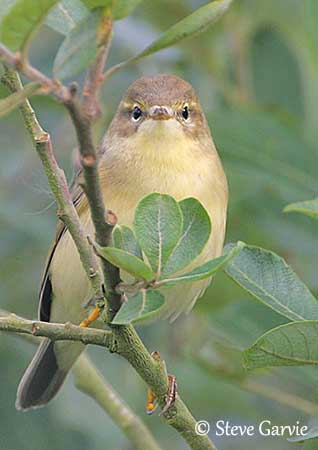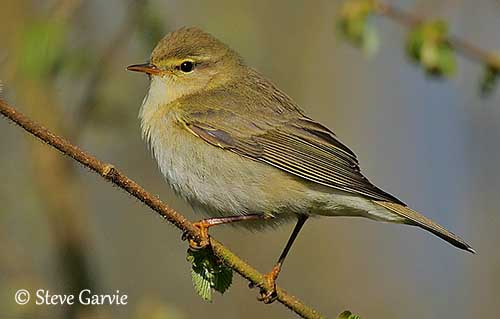
Fr: Pouillot fitis
Ang: Willow Warbler
All: Fitis
Esp: Mosquitero Musical
Ita: Luì grosso
Nd: Fitis
Sd: Lövsångare
Photographes:
John Anderson
John Anderson Photo Galleries
Steve Garvie
RAINBIRDER Photo galleries & Flickr Rainbirder
Eugène Montocchio
Galerie Photos Nature
Otto Plantema
Trips around the world
Nicole Bouglouan
PHOTOGRAPHIC RAMBLE
Texte de Nicole Bouglouan
Sources :
HANDBOOK OF THE BIRDS OF THE WORLD Vol 11 by Josep del Hoyo, Andrew Elliott and David Christie - Lynx Edicions - ISBN: 849655306X
THE COMPLETE BOOK OF BRITISH BIRDS – Written by “Royal Society for the Protection of Birds” experts - Préface de Magnus Magnusson - Michael Cady- Rob Hume Editors - ISBN: 0749509112
THE HANDBOOK OF BIRD IDENTIFICATION FOR EUROPE AND THE WESTERN PALEARCTIC by Mark Beaman, Steve Madge - C. Helm - ISBN: 0713639601
ENCYCLOPEDIE DES OISEAUX DE FRANCE ET D’EUROPE – de Peter Hayman et Rob Hume - Flammarion – ISBN : 2082009920
Biodiversity Explorer – The Web of Life in Southern Africa
Wikipedia, the free encyclopaedia
Zoologiska institutionen – Stocholms universitet
Effects of climate change on phenology in the willow warbler
Home page
Page Passeriformes Order
Willow Warbler
Phylloscopus trochilus
Passeriformes Order – Phylloscopidae Family
INTRODUCTION:
The Willow Warbler is very similar to the Common Chiffchaff, but they can be easily separated by their very different song and call. When silent, some morphological features allow identifying each species, although some variations in both birds can mislead us.
The Willow Warbler is more elongated and sleeker than the Common Chiffchaff, with less rounded crown and longer primary projection. The legs are usually paler.
However, some Willow Warblers are sometimes small and dumpy (probably females), and the primary projection is useful in such cases. In addition, they may have dusky brown legs whereas some Common Chiffchaffs have light brown legs.
The Willow Warbler is migratory. It breeds in northern and temperate regions of Europe and Asia, and winters in sub-Saharan Africa.

DESCRIPTION OF THE BIRD:
Biometrics:
Length: 11-12,5 cm
Weight: 6,3-14-6 g
The adult of nominate race has olive green upperparts. The flight feathers have brighter or greenish-yellow edges, like rectrices and rump feathers. The other flight feathers are brownish.
The underparts are pale yellow in fresh plumage and dull whitish in worn plumage. Throat and breast are tinged or streaked yellow. The undertail-coverts are pale yellowish. On the underwing, axillaries and coverts are bright yellow.
On the head, the crown is olive-green. We can see a conspicuous, narrow, whitish-yellow supercilium extending from bill base to above ear-coverts, often whiter behind the eye. There is a narrow, dark olive eye stripe of same length. Cheeks and ear-coverts are pale olive-green with yellow wash, usually whiter in worn plumage.
The bill is dark brown, sometimes yellowish to orange at base of lower mandible. The eyes are dark brown. Legs and feet are pale brown to brownish-pink. However, they can be occasionally darker or greyer.
The Willow Warbler is slender and shows more elongated shape than the Common Chiffchaff. Upperparts and underparts are lighter or yellower in fresh plumage. The supercilium is more conspicuous, legs are usually paler, the primary projection is longer and the bill is slightly longer and more pointed.
Male and female are similar, and unlike most birds, they moult their feathers twice a year, once at their breeding grounds and once at their wintering areas.
The juvenile has pale yellow supercilium, and shows extensive pale yellow on the underparts, but chin and undertail are whiter, and the breast is washed buffish.
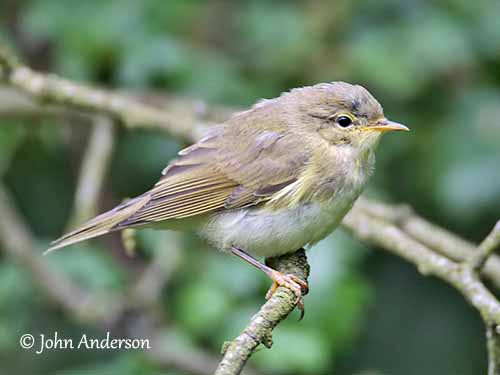
SUBSPECIES AND RANGE:
The Willow Warbler has three recognized subspecies.
P.t. trochilus (described above) breeds in Ireland, Britain and S Sweden, S to N Spain and C and NW France, E to S Poland and Romania. It winters in W Africa.
P.t. acredula breeds in Scandinavia (except S Sweden) and C and E Europe, E to C Siberia. It winters in Africa, S of Sahara.
This race resembles nominate, but it is greyer overall, less green-tinged. It is more grey-brown towards east. In extreme east of the range, the upperparts are brownish and lack olive green, and the underparts are whitish.
P.t. yakutensis breeds in C and E Siberia. It winters in E and South Africa.
This one has whitish supercilium, more conspicuous than nominate. The upperparts are grey-brown with sometimes some olive green on rump and edges of flight feathers and tail feathers. The underparts are dull white, with greyish streaks or spots on breast, and yellow underwing-coverts.
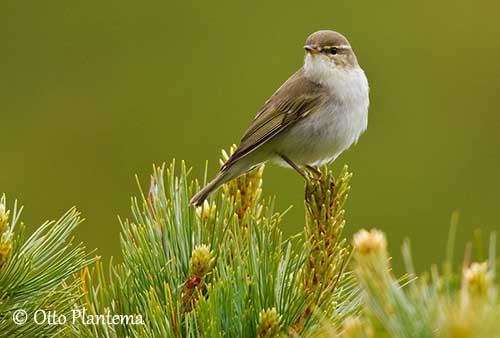
HABITAT:
The Willow Warbler breeds in a variety of woodlands and scrub. It frequents generally mature woodland, hedgerows and scrub in open country, but it is mainly found in clearings, plantations, heathland, orchards and bushy areas. It usually avoids tall, pure stands of spruce and other conifers. It breeds on slopes covered in scrub in mountainous areas up to 1000 metres of elevation.
Outside the breeding season, it is often found in Acacia and Brachystegia woodland, and at the edges of riverine forest and dry evergreen forest. It also frequents grassy areas, swamps and mangroves in W Africa. It may occur up to 3500 metres in Tanzania and DR Congo.
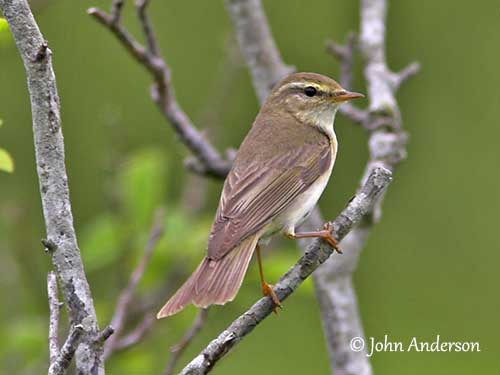
CALLS AND SONGS: SOUNDS BY XENO-CANTO
The Willow Warbler’s typical call is a soft “hoo-eet” with rising inflection. The song is a series of sweet, rather melancholy “swee” notes increasing gradually in volume before descending in long, terminal flourish.
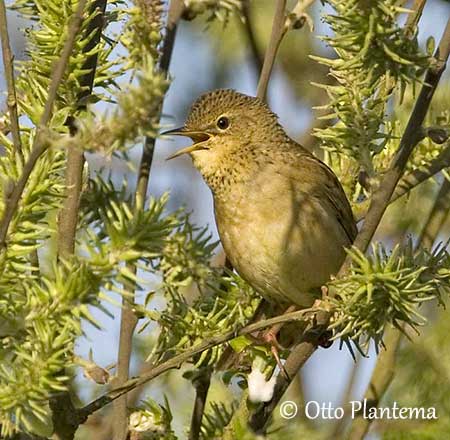
BEHAVIOUR IN THE WILD:
The Willow Warbler feeds on a variety of invertebrates including insects, their eggs and their larvae, spiders and small snails. In autumn, it also consumes plant material such as fruit and berries, and seeds of bramble (Rubus fruticosus).
It gleans insects from among foliage, taking them from leaves and twigs, and also on the wing. It hovers and performs short flycatching sallies. It may forage alone or in small groups.
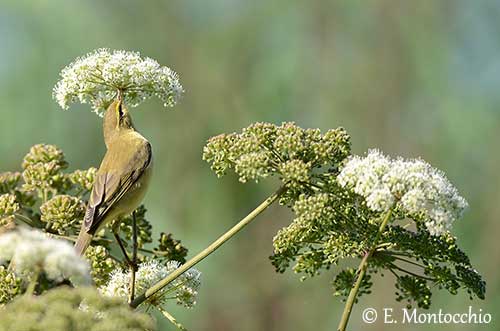
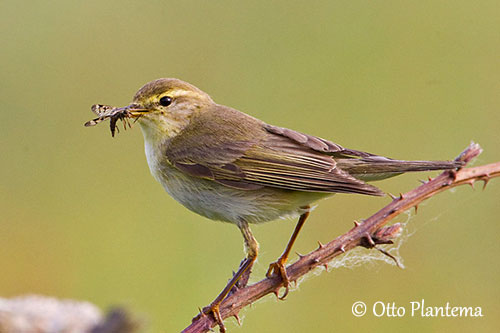
During the breeding season, the Willow Warbler defends aggressively the territories. The male is often polygamous and has primary and secondary territories. Fights are frequent and disputes often continue until the laying period.
In order to form the pair, the female enters a male’s territory and the male approaches with steady, stiff wingbeats or by gliding on raised wings, while giving soft calls. Then, on landing, the head is held forwards and the wings dropped, but the head is sometimes swayed from side to side.
The male chases the female in courtship. It fans its tail and does nervous wing flicking while uttering twittering calls.
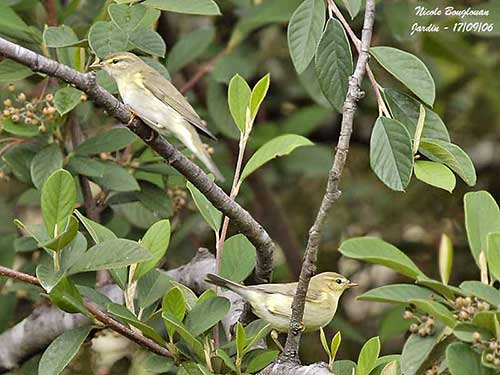
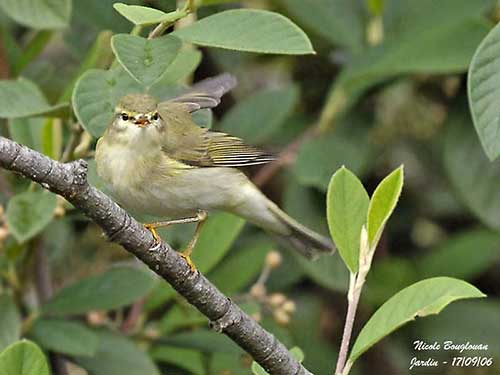
The Willow Warbler is migratory and moves S after breeding to winter in Africa S of Sahara. It leaves the breeding grounds in late August/early September. Stopovers occur in C Iberia and Mediterranean areas to put on fat for a non-stop flight to S of Sahara.
The return passage starts in late February and March in S and W Africa. They usually arrive at their breeding grounds between April and July depending on the range.
The Willow Warbler may hover briefly and sally out after insects in flycatcher-like action. During migration, the fly is fast and jerky. It has long, pointed wings, indicating a long-distance migrant.
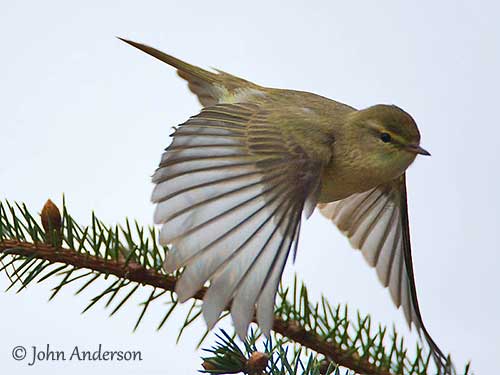
REPRODUCTION OF THIS SPECIES:
The breeding season takes place between April and July. The female builds the nest while the male collects materials. The nest is placed on or near the ground, well hidden among the vegetation, sometimes up to 4-8 metres in tree or creeper. It is ball-shaped, and made with dry grasses, leaves, plant-fibres, moss, bark, animal hair and feathers.
The female lays 4-8 eggs, and incubates during 12-14 days. The chicks are fed mainly by the female, but the male may assist. The young fledge 11-15 days after hatching, and they are independent 12-16 days after leaving the nest. This species usually produces a single clutch per year.
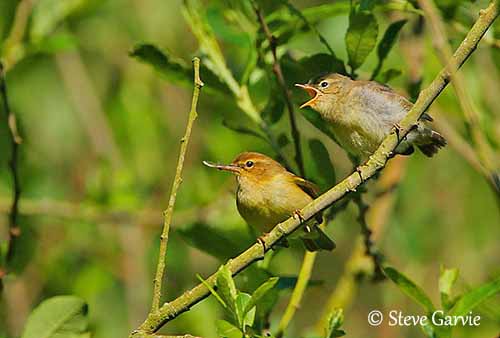
PROTECTION / THREATS / STATUS:
The Willow Warbler has very wide range in which it is common to locally abundant.
A preliminary estimate of the global population size is 343,000,000/1,200,000,000 individuals, but further validation of these numbers is needed.
But currently, the Willow Warbler is evaluated as Least Concern.
